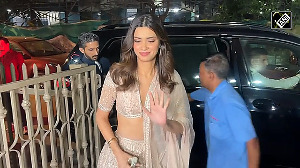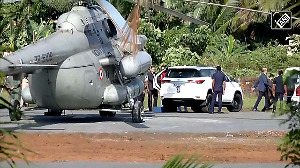Here we go, with another World Cup. Through its 54-day duration, we will be engaged in furious debate: Which is the best team? Who are the best bowlers, the best batsmen? Who will win, who will lose?
And above all, the big one: when the dust settles, when the Cup is won and lost, who will emerge as the first among equals, the Most Valuable Player of them all?
The debate has, in past years, been endless, fascinating and, mostly, inconclusive. Though each World Cup enshrines one individual as MVP, it is invariably a bland announcement, without explanation or argument, without debate.
Here's where we change all that. Rather than debate the MVP at the end of the tournament, we begin at the beginning -- and, as the Cup gets under way, we ask: what makes a cricketer valuable, in the one-day format?
Some qualities are obvious. Thus, if he is a batsman, he must score a lot of runs, and he must score those runs very quickly.
If he is a bowler, he should take a lot of wickets, and while doing that, he should concede as few runs as possible.
As a fielder, he should take all the catches that come his way, create catches out of half chances, help effect run outs, save runs, and create pressure on the batsmen.
Before the 2003 World Cup, we had prepared a list of the statistically most valuable players.
Chris Gayle, Jacques Kallis, Chris Cairns, Sachin Tendulkar and Sanath Jayasuriya were the top five in that list.
This wasn't particularly surprising: all-rounders always have more opportunities to add value. So, outstanding all-rounders: great batsmen who bowl a bit, or great bowlers who can bat a bit, are always likely to be nearer the top.
Four years later, we have tried to prepare an MVP list for 2007 using essentially the same rules, but after tweaking the variables slightly.
In 2007, we will assume that the average score of an ODI team is 240 (it was 225 in 2003). This, in turn, implies an average strike rate of 80 (80 runs in 100 balls) for the batsman, and an average economy rate of 4.8 (48 runs conceded in 10 overs) for the bowler.
Every batsman gets a point for every run scored, and bonus points if his strike rate is better than 80.
For example, if Dravid scores 100 in 100 balls, he gets 120 points: 100 points for the 100 runs and 20 bonus points because he scored 100 when he was expected to score only 80 in 100 balls. If, however, he scores 60 in 100 balls, he gets only 40 points: 60 points for the 60 runs but 20 negative points because he was expected to score 80 in 100 balls.
A bowler can earn points by taking wickets and bowling economically.
This time, we are giving the bowler 24 points for a wicket; instead of 20, because our simulations indicated that 20 points were too low, and therefore unfair to the bowler. The bowler can also earn points if he gives away less than 48 runs in a 10-over spell.
So, if Harbhajan has figures of 10-1-55-3, he gets 72 points for his 3 wickets, but loses 7 points because of a poorer economy rate, to end up with 65 points. If Kumble's figures are 10-2-31-2, he too gets 65 points.
Finally, a fielder can earn 5 points for every catch, 24 points for a direct run out, and share 24 points with his partners who participate in a run out. A wicket keeper can earn 5 points for a catch, 10 points for a stumping and also get his share of 24 points if he participates in a run out dismissal.
We've tried to keep it simple; so we don't, for example, give a bowler fewer points if he dismisses a tail-ender, or reward a batsman more if he wins a man of the match award, scores a century or remains not out. But we believe that our formulation still gives a realistic picture of an ODI player's performance.
Right through the 2007 World Cup, Rediff will track the emerging "most valuable player" score. It won't surprise us if the eventual player of the series is also Rediff's most valuable player!
To guess who might become the "most valuable player" at the 2007 World Cup, we looked at how leading players have performed in their last 20 ODIs and last 50 ODI matches. Run outs were not considered in this list because it's not easy to obtain the names of the fielders participating in a dismissal from the available data archives.
The tables below lists the top 50 ODI players based on their performance in their last 20 ODI games (which is approximately the last 6-9 months), and their last 50 games (translates to the last 15-18 months).
MVP based on the player's last 20 matches
| Rank | Player | Country | Runs | Balls | Ct | St | Rc | Bb | W | Total | Average |
| 1 | Sanath Jayasuriya | SL | 902 | 775 | 4 | 435 | 582 | 11 | 1498.6 | 74.93 |
| 2 | Shaun Pollock | SA | 339 | 355 | 7 | 535 | 1056 | 31 | 1482.8 | 74.14 |
| 3 | Chris Gayle | WI | 719 | 774 | 12 | 590 | 766 | 20 | 1381.6 | 69.08 |
| 4 | Jacques Kallis | SA | 657 | 903 | 6 | 554 | 673 | 24 | 1182.0 | 59.10 |
| 5 | Andrew Flintoff | Eng | 498 | 642 | 5 | 609 | 841 | 21 | 1075.2 | 53.76 |
Sanath Jayasuriya heads the list. He has scored a lot of runs, and at a blinding strike rate of 116. He also has 11 wickets at a very decent economy rate.
If Jayasuriya is the top batting all-rounder going into the World Cup, Pollock is certainly the top bowling all-rounder. He has 31 wickets at an economy rate of just over 3 an over; and he's scored a few handy runs at a fair clip.
Gayle, Kallis and Flintoff occupy the next three places, qualifying as genuine all-rounders. Gayle is well ahead of the other two because of his strike rate of 97 (Kallis and Flintoff are 73 and 78 respectively) and sufficiently respectable economy rate (4.67; Kallis and Flintoff are 4.94 and 4.34 respectively).
Further down the list we have a mix of high-scoring and attacking batsmen (Ponting, Pietersen, Smith, Sangakkara and Tendulkar) and high wicket-taking bowlers with a fair economy rate (Bond, Lee, Vettori, Ntini, Bracken, Murali and Vaas). High utility players like Symonds, Collingwood and Bravo are also in the same cluster.
Pure middle-order batsmen and pure first-change bowlers fare rather poorly in this analysis. That's why Dravid, Inzamam, Hussey, Jayawardene, Fleming, Lara, Sarwan and Yousuf among the batsmen, and Bradshaw, McGrath, Nel and Harbhajan Singh among the bowlers figure far lower down the list than expected.
MVP based on the player's last 50 matches
| Rank | Player | Country | Runs | Balls | Ct | St | Rc | Bb | W | Total | Average |
| 1 | Andrew Flintoff | Eng | 1509 | 1732 | 11 | 1625 | 2104 | 56 | 3089.6 | 61.79 |
| 2 | Chris Gayle | WI | 1760 | 2039 | 27 | 1512 | 1921 | 39 | 2984.6 | 59.69 |
| 3 | Shaun Pollock | SA | 641 | 686 | 14 | 1513 | 2550 | 65 | 2890.2 | 57.80 |
| 4 | Andrew Symonds | Aus | 1585 | 1643 | 25 | 1468 | 1739 | 41 | 2887.8 | 57.76 |
| 5 | Sanath Jayasuriya | SL | 1809 | 1804 | 6 | 967 | 1220 | 23 | 2765.8 | 55.32 |
We see that the clustering of players continues to follow the same pattern, although some names are juxtaposed based on the player's form or injury. Irfan Pathan is high up in the last-50-match list, as indeed are Symonds and Gilchrist. Yuvraj and Dhoni too figure much more prominently, but Sehwag's decline is already clearly visible.

This feature, the first in a regular series on the Most Valuable Player of the World Cup, is powered by Cranes Software. All the data collection and computer programming to calculate the MVP was carried out by K Anil Kumar and Debasish Ghosh of Cranes Software International Limited, Bangalore.





